Carl Linnaeus
![]()
This article explains the developer of the Linnéan system. For his son of the same name, see Carl von Linné (son). For the German politician of similar name, see Carl Linné (politician).
Carl von Linné ![]() (Latinized Carolus Linnaeus; before elevation to the peerage in 1756 Carl Nilsson Linnæus; * 23 May 1707 in Råshult near Älmhult; † 10 January 1778 in Uppsala) was a Swedish naturalist who created the foundations of modern botanical and zoological taxonomy with binary nomenclature. His official botanical author code is "L. ". In zoology, "Linnaeus", "Linné" and "Linnæus" are used as author names.
(Latinized Carolus Linnaeus; before elevation to the peerage in 1756 Carl Nilsson Linnæus; * 23 May 1707 in Råshult near Älmhult; † 10 January 1778 in Uppsala) was a Swedish naturalist who created the foundations of modern botanical and zoological taxonomy with binary nomenclature. His official botanical author code is "L. ". In zoology, "Linnaeus", "Linné" and "Linnæus" are used as author names.
As a student, Linné dealt with the still new idea of the sexuality of plants in his manuscript Praeludia Sponsaliorum Plantarum and laid the foundation for his later work with these considerations. During his stay in Holland he developed the theoretical foundations of his work in writings such as Systema Naturae, Fundamenta Botanica, Critica Botanica and Genera Plantarum. During his work for George Clifford in Hartekamp Linné could study for the first time many rare plants directly and created with Hortus Cliffortianus the first plant directory arranged after his principles. After his return from abroad Linné worked for a short time as a doctor in Stockholm. Here he belonged to the founders of the Swedish Academy of Sciences and was its first president. Several expeditions led him through the provinces of his Swedish homeland and contributed to his recognition.
At the end of 1741 Linné became professor at the University of Uppsala and nine years later its rector. In Uppsala he continued his encyclopedic efforts to describe and order all known minerals, plants and animals. His two works Species Plantarum (1753) and Systema Naturæ (in the tenth edition of 1758) established the scientific nomenclature in botany and zoology still used today.
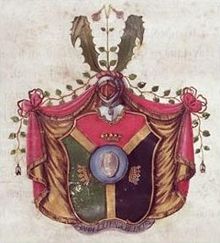
Linné's coat of arms symbolizes the three natural kingdoms of minerals, plants and animals and was designed by himself. In the blue oval in the middle an egg is depicted. The helmet above it is decorated with the plant Linnaea borealis (moss bell) named after him.

Linné's portrait a few years before his death was painted by Alexander Roslin (1775).
Live
Childhood and school
Carl Linnæus was born on 23 May 1707 in the first hour after midnight in the small village of Råshult in Stenbrohult parish in the southern Swedish province of Småland. He was the eldest of five children of the clergyman Nils Ingemarsson Linnæus and his wife Christina Brodersonia.
His father was very interested in plants and cultivated some unusual plants from Germany in his garden. This fascination was passed on to his son, who took every opportunity to go on forays into the surrounding area and have his father tell him the names of the plants. His schooling began at the age of seven by a private tutor who taught him for two years. In 1716 his parents sent him to the newly built cathedral school in Växjö with the aim that he would later become a priest like his father and grandfather. The young Linné suffered under the rigid education methods of the school. This changed only when he made 1719 the acquaintance of the student Gabriel Höök, who taught him privately. In 1724 he changed to the Gymnasium.
In 1726 his father traveled to Växjö to consult the physician Johan Stensson Rothman on a medical matter and to find out about his son's performance. He had to learn that his son's performance in the subjects necessary for the priesthood, Greek, Hebrew, theology, metaphysics and rhetoric, was mediocre and he showed little interest in them. In contrast, his son excelled in mathematics and the sciences, as well as Latin. Rothman, recognizing Linné's talent for a medical career, offered the shocked father to take his son into his home free of charge and teach him botany and physiology. Rothman introduced Linné to the classification system of plants by Joseph Pitton de Tournefort and pointed him to Sébastien Vaillant's writing on the sexuality of plants.
Study
In August 1727 Linné went to Lund to study at the university there. At the end of his school time he had received a not very flattering letter from the rector of the grammar school Nils Krok for his application in Lund. His old friend Gabriel Höök, by now a master of philosophy at Lund, advised him not to use the letter. Instead, he introduced Linné to the rector of Lund University as his private student and thus achieved matriculation at Lund University. Höök convinced Professor Kilian Stobæus to accept Linné into his house. Stobæus possessed beside a rich natural collection a very extensive library, which Linné was not allowed to use, however. By the German student David Samuel Koulas, who was employed at times as a secretary of Stobæus, he got nevertheless access to the books, which he studied until late at night. In return he imparted to Koulas his knowledge of physiology learned from Rothman. Astonished at the nocturnal activities of his pupil, Stobæus abruptly entered Linné's room one night and found him, to his surprise, absorbed in the study of the works of Andrea Cesalpino, Caspar Bauhin, and Joseph Pitton de Tournefort. From then on, Linné had free access to the library.
During his stay in Lund, Linné made regular excursions into the surrounding area. So also on a warm day at the end of May 1728, when he explored the nature in Fågelsång with his fellow student Mattias Benzelstierna and was bitten by a small, inconspicuous animal, the "hell-fury". The wound became infected and could be treated only with difficulty. Linné narrowly escaped death. To the recovery Linné went in the summer to his homeland. Here he met his teacher Rothman again, to whom he reported of his experiences at the University of Lund. By this report Rothman, who had studied at the university of Uppsala, came to the conviction that Linné should continue his medicine study better in Uppsala. Linné followed this advice and left for Uppsala on September 3, 1728.
The conditions which Linné found at the university there were desolate. Olof Rudbeck the younger gave a few lectures on birds and Lars Roberg philosophized on Aristotle. There were no lectures on medicine and chemistry, no autopsies were performed, and barely two hundred species grew in the old botanical garden. In March 1729 Linné made the acquaintance of Peter Artedi, with whom he had a firm friendship until the latter's early death. Artedi's main interest was chemistry, but he was also a botanist and zoologist. The two friends tried to outdo each other in their research. They soon realized that it would be better if they divided the various fields of the three kingdoms of nature among themselves according to their interests. Artedi took over the amphibians, reptiles and fishes, Linné the birds and insects, and, with the exception of the umbellifers, all botany. Together they worked on the mammals and the minerals.
Around this time, Olof Celsius the Elder took him into his home. Linné helped Celsius with the completion of his work Hierobotanicon. Linné's financial situation improved. In June 1729 he received a royal grant (II. class), which was increased again in December 1729 (I. class). At the end of 1729 he wrote his first important paper Praeludia Sponsaliorum Plantarum, in which he dealt with the sexuality of plants for the first time and which paved the way for his further life's work. The paper quickly became famous and Olof Rudbeck sought Linné's personal acquaintance. First he got Linné, against the resistance of Roberg, the position of the demonstrator of the botanical garden and hired him as a teacher of his three youngest sons. In the middle of June Linné moved into Rudbeck's house.
In 1730/31 Linné worked on a catalogue of the plants of the botanical garden of Uppsala (Hortus Uplandicus, later title Adonis Uplandicus), of which several versions were created. At the beginning the plants were still arranged according to Tournefort's system for the classification of the plants, about whose validity Linné came, however, more and more doubts. In the final version of July 1731, which he finished in Stockholm, he arranged the plants according to his own system consisting of 24 classes. During this time he wrote the first drafts of his early works, which were published in Amsterdam. At the end of 1731 Linné saw himself induced to leave Rudbeck's house, because the wife of the university librarian Andreas Norrelius (1679-1750), who also lived there during this time, spread rumours about him, which undermined the good relationship with Rudbeck's family. He spent the turn of the year with his parents.
Journey through Lapland
→ Main article: Expedition to Lapland
In a letter of 26 December 1731 Linné recommended himself to the Royal Society of Sciences in Uppsala for an expedition to the largely unexplored Lapland and asked for the necessary financial support. When he received no reply, he made another attempt at the end of April 1732 and reduced the amount of money needed for the journey by a third. This time the amount was granted and he began his first major expedition on 23 May.
The arduous journey, during which he recorded all his experiences and discoveries in a diary, lasted just under five months. On 21 October 1732 he arrived again in Uppsala. To the strains of the journey and the debts which Linné had taken on in addition, the disappointment came that the academy published only few pages of his results. His book on the Lapland flora, Flora Lapponica, was not published until 1737 in Amsterdam.
From this journey he brought back for the first time the rules and board of the game Tablut, which was very popular in Viking times.
Falun and the journey through Dalarna
In the spring semester of 1733, Linné held private courses in docimastics and wrote a short treatise on the subject, which was new to him. He catalogued his collection of birds and insects and worked on numerous manuscripts. He received an invitation from Clas Sohlberg, one of his students, to spend the turn of the year 1733/1734 with his family in Falun. Clas' father, Eric Nilsson Sohlberg, was inspector of the mines there, and thus the possibility arose for Linné to study the work in the mines extensively. He returned to Uppsala only in March 1734 and continued to give private lessons in mineralogy, botany and dietetics.
During the stay in Falun Linné made the acquaintance of Johan Browall, who taught the children of the governor of the province Dalarna, Nils Reutersholm. Reutersholm was impressed by the reports of Linné's Lapplandreise and planned to accomplish such an exploration journey in the province administered by him. Enough backers were found for the enterprise, and the Societas Itineraria Reuterholmiana (Reuterholm Travel Society), consisting of eight members and presided over by Linné as president, was founded. The journey through the province Dalarna began on 3 July 1734 and lasted until 18 August 1734. Linnés travel report Iter Dalecarlicum was published only posthumously.
Linné stayed in Falun and took over the teaching of Reutersholm's sons. Browall persuaded him to go abroad to obtain his doctorate, which had hitherto been denied him because of his strained financial situation. Eventually a solution was found for the travel expenses. Linné was to accompany Clas Sohlberg to Holland to teach and obtain his doctorate there. He returned to Uppsala to make his travel arrangements and, after a shorter stay in Stockholm, arrived back in Falun at the end of the year. At the turn of the year 1734/35 he met Sara Elisabeth Moraea, a daughter of the town doctor of Falun, and proposed marriage to her. This was accepted by her father, who was anxious for the economic independence of his daughter, under the condition that Linné would acquire his doctorate and the wedding would take place within the next three years.
Three years in Holland
Linné's journey southwards led him via Växjö and Stenbrohult. On 15 April 1735 he set off from Stenbrohult for Germany. At the beginning of May he reached Travemünde and immediately went to Lübeck, from where he travelled by stagecoach to Hamburg the next morning. Here he met Johann Peter Kohl, the editor of the journal Hamburgische Berichte von Neuen Gelehrten Sachen. He visited the extensive garden of the jurist Johann Heinrich von Spreckelsen, where he counted, among other things, 45 species of aloe and 56 species of midday flowers. Also he paid a visit to the library of Johann Albert Fabricius. When Linné carelessly exposed a seven-headed Hydra, which was for sale at a high price and belonged to the brother of the Hamburg mayor Johann Anderson, as a fake, the physician Gottfried Jacob Jänisch advised him to leave Hamburg quickly to avoid possible trouble. Thus Linné already set off on 27 May from Altona to Holland.
On 13 June Linné arrived in Amsterdam. Here he stayed only a few days and sailed on the evening of June 16 to Harderwijk to finally receive the long-awaited degree as doctor of medicine. That same day he enrolled in the Album Studiosorum of the University of Harderwijk. Two days later he passed his examination as Candidatus Medicinae under Johannes de Gorter and handed over to him his dissertation Hypothesis Nova de Febrium Intermittentium Causa, which he had already completed in Sweden. He spent the remaining days until his examination botanizing with David de Gorter, the son of his examiner. On Wednesday, June 23, 1735, he passed his examination, and, having received his diploma, returned to Amsterdam the very next day. Here he lingered but a short time, for he was anxious to meet Herman Boerhaave, who was working at Leiden. The meeting at Boerhaave's country estate Oud Poelgeest only came about due to the support of Jan Frederik Gronovius, who issued him a letter of recommendation. Earlier, Linné had shown Gronovius and Isaac Lawson some of his manuscripts, including a first draft of Systema Naturae. Both were so impressed by the originality of Linné's approach to classifying the three kingdoms of nature, minerals, plants and animals, that they decided to publish the work at their own expense. Gronovius and Lawson acted as proofreaders for this and other works by Linné produced in Holland and supervised the progress of the printing.
On Boerhaave's recommendation, Linné found work and accommodation with Johannes Burman, whom he helped compile his Thesaurus Zeylanicus. In Burman's house Linné finished his work Bibliotheca Botanica and met there on recommendation of Gronovius the banker George Clifford. Gronovius had suggested to Clifford to employ Linné as curator of his collection in Hartekamp and to let him describe his garden, the Hortus Hartecampensis. On September 24, 1735, Linné began his work at Hartekamp. Only five days later he received the message that his friend Peter Artedi, whom he had met by chance in Amsterdam only a few weeks before, had drowned in an Amsterdam canal. Linné fulfilled the mutual promise of the friends to continue and publish each other's work and edited and published Artedi's works during his time in Holland.
Soon after Linné's arrival at Hartekamp, the German plant draughtsman Georg Dionysius Ehret arrived there, who was employed by Clifford as a draughtsman for a time. Linné explained to him his new classification system for plants, whereupon Ehret, at first for his private use, made a drawing with the distinguishing features of the 24 classes. The plate, entitled Caroli Linnaei classes sive literae, was occasionally bound together with the first edition of Linné's Systema Naturae and formed part of several other of his works. In Hartekamp Linné worked on several projects at the same time. Thus his works Fundamenta Botanica, Flora Lapponica, Genera Plantarum and Critica Botanica were written here and went page by page after correction to the printer. Along the way, with the help of the German gardener Dietrich Nietzel, he succeeded in bringing the banana plant growing in one of Clifford's warm houses to flower and fruit. This event prompted him to write the treatise Musa Cliffortiana. The work is the first monograph on a plant genus.
England and France
In the summer of 1736 Linné's work in Holland was interrupted by a trip to England. In London he studied Hans Sloane's collection and received rare plants for Clifford's garden from Philip Miller of the Chelsea Physic Garden. During the month-long stay he met with Peter Collinson and John Martyn. During a short stay at Oxford he met Johann Jacob Dillen. Back in Hartekamp Linné worked under the increasing pressure of Clifford on the Hortus Cliffortianus further, whose completion was delayed however particularly due to problems with the copper engravings until 1738.
In the summer of 1737, Boerhaave offered him the post of physician to the WIC, the Dutch West India Company in Dutch Guiana. However, he declined and recommended Boerhaave instead the physician Johann Bartsch, who had helped him with the editing of his Flora Lapponica. By this time Linné had plans to leave Holland again, and turned down all Clifford's offers to stay at his expense. Only when Adriaan van Royen asked him to rearrange the botanical garden in Leiden according to his system and to stay at least for the winter, Linné gave in. His travel plans stood meanwhile firmly. Over France and Germany, where he hoped to meet among other things Albrecht von Haller in Göttingen, he wanted to return finally to Sweden. A severe fever, from which he suffered for several weeks at the beginning of 1738, delayed the departure, however, more and more.
In May 1738 Linné had recovered so far that he could start the journey to France. From Leiden he travelled via Antwerp, Brussels, Mons, Valenciennes and Cambrai to Paris. Van Royen had given him a letter of recommendation to Antoine de Jussieu. The latter, lacking time, entrusted him to the care of his brother Bernard de Jussieu, who at that time held the chair of botany at the Jardin du Roi. Together they visited the Royal Garden, the herbaria of Joseph Pitton de Tournefort, Sébastien Vaillant and Joseph Donat Surian, as well as the book collection of Antoine-Tristan Danty d'Isnard, and undertook botanical excursions in the surroundings of Paris.
During a meeting of the Paris Academy of Sciences Linné became a corresponding member of the Academy due to a proposal of Bernard de Jussieu. The superintendent of the Jardin du Roi Charles du Fay tried in vain to convince Linné to stay in France. Linné, however, wanted to return to his homeland at last. He gave up the plan to travel to Germany and, after a month's stay in France, embarked for Sweden in Rouen.
Return to Sweden and marriage
Via the Kattegat Linné arrived in Helsingborg. After a short stay with his family in Stenbrohult he travelled on to Falun, where shortly afterwards the engagement with Sara Elisabeth Moraea took place. In order to earn a living, he settled in Stockholm as a physician in September 1738. After initial difficulties, he quickly gained access to Stockholm society through his acquaintance with Carl Gustaf Tessin. Together with Mårten Triewald, Anders Johan von Höpken, Sten Carl Bielke, Carl Wilhelm Cederhielm and Jonas Alströmer he founded the Royal Swedish Academy of Sciences in May 1739 and became its first president. In accordance with the statutes, he relinquished the presidency at the end of September 1739.
Also in May 1739 he became Triewald's successor at the Royal College of Mines in Stockholm, where he lectured on botany and mineralogy, and, on the recommendation of Admiral Theodor Ankarcrona, physician to the Swedish Admiralty.
Thus financially secured, he was able to marry his fiancée Sara Elisabeth Moraea on 26 June 1739. The marriage produced seven children: Carl, Elisabeth Christina, Sara Magdalena, Lovisa, Sara Christina, Johannes and Sofia. Sara Magdalena and Johannes died in infancy. Linné's son Carl of the same name became a botanist like his father, but was only able to continue his father's work for a short time and died at the age of 42.
Journey through Öland and Gotland
One month after his wedding Linné returned to Stockholm. In January 1741 he received an offer from the Ständereichstag to explore the islands of Öland and Gotland. Linné and his six companions, including Johan Moraeus, a brother of his wife, set out from Stockholm on 26 May 1741. They were on the road for two and a half months, and their activities in the run-up to the Russo-Swedish War sometimes aroused suspicion of Russian espionage activities. With the publication of the travelogue Ölandska och Gothländska Resa in 1745, Linné had for the first time written a work in his native Swedish language. Remarkable is the index of the work, in which the plants were named in an abbreviated two-part manner. In addition, a numerical index referred to the species in the work Flora Suecica, which was published in the same year.
Professor in Uppsala
In the spring of 1740, Olof Rudbeck died, and his chair of botany at Uppsala University had to be filled. Lars Roberg, holder of the chair of medicine, wanted to retire soon, so that this chair also had to be reassigned. Beside Linné there were with Nils Rosén of Rosenstein and Johan Gottschalk Wallerius two other candidates. In agreement with the Swedish chancellor Carl Gyllenborg Rosén should get Rudbeck's position and Linné the vacant position of Roberg. Later they should exchange the chairs. Linné's official appointment as professor of medicine took place on 16 May 1741. In his "speech of the importance to travel in his own country" on the occasion of taking over the chair, which he held on 8 November 1741, he emphasized the economic benefit of mapping Swedish nature. However, it was not only important to study nature, but also local diseases, their cures and the various agricultural methods. His first public lecture took place less than a week later.
At the end of the year Linné and Rosén exchanged the chairs. Linné taught botany, dietetics, materia medica and had the supervision of the Old Botanical Garden. Rosén taught practical medicine, anatomy and physiology. For the fields of pathology and chemistry they were jointly responsible. Linné began with the reorganization of the Botanical Garden and assigned Carl Hårleman with it. The house of Olof Rudbeck the older belonging to the garden was renovated and Linné moved there with his family. New greenhouses were built in the garden and plants from all over the world were introduced. In his work Hortus Upsaliensis Linné described in 1748 about 3000 different plant species that were cultivated in this garden. In his Materia medica, a manual for physicians and pharmacists published in 1749, he described medicinal plants and their practical uses. In 1750 he became rector of the University of Uppsala. He held this position until a few years before his death.
Before taking office as rector, Linné had made two more journeys through Sweden. From 23 June to 22 August 1746 he travelled through the province of Västergötland together with Erik Gustaf Lidbeck, who later became professor in Lund. Linnés notes appeared one year later under the title Västgöta Resa. A last journey led Linné from May 10 to August 24, 1749 through the southernmost Swedish province Skåne. His student Olof Andersson Söderberg, who had received his doctorate from him the previous year and was later a professor in Halle, assisted him during the trip as his secretary. The Skånska Resa was published in 1751. In mid-December 1772 he delivered his farewell address on "The Pleasures of Nature".
Species Plantarum
→ Main article: Species Plantarum
Linné's travels through Sweden enabled him to describe the plant and animal world of Sweden in detail in the works Flora Suecica (1745) and Fauna Suecica (1746). They were important steps towards the completion of his two most significant works, Species Plantarum (first edition 1753) and Systema Naturae (tenth edition 1759). Linné encouraged his students to explore the nature of unexplored regions for themselves, and also provided them with the means to do so. He called the students who went on a voyage of discovery "his apostles".
In 1744, the Danish pharmacist August Günther sent him five volumes of the herbarium made by Paul Hermann in Ceylon from 1672 to 1677 and asked Linné to help him identify the plants. Linné could use about 400 of the approximately 660 herbarized plants and classify them in his classification system. He published his results in 1747 as Flora Zeylanica.
In 1750, a severe attack of gout forced Linné to dictate the contents of Philosophia Botanica (1751) to his student Pehr Löfling. The work, based on his 365 aphorisms formulated in Fundamenta Botanica, was conceived as a textbook of botany. In it, he presented his system for distinguishing and naming plants and explained it through concise commentaries. From mid 1751 to 1752 Linné worked intensively on the completion of Species Plantarum. In the two volumes published in the middle of 1753 he described on 1200 pages with about 7300 species all plants of the earth known to him. Of special importance is the epithet, which he noted as marginalia to each species in the margin of the page and which was an innovation compared to his earlier works. The generic name and the epithet together form the two-part name of the species, as it is still used today in modern botanical nomenclature.
Systema Naturae
→ Main article: Systema Naturae
In the year of publication of Species Plantarum appeared with Museum Tessinianum a list of the objects of the mineral and fossil collection of Carl Gustaf Tessin, which Linné had made. The collecting of natural-historical curiosities was also very common in Sweden at that time. Adolf Friedrich had assembled a collection of rare animal species in Drottningholm Palace and commissioned Linné to make an inventory of them. Linné spent for it in the years 1751 to 1754 altogether nine weeks in the castle of the king. The first volume of Museum Adolphi Friderici (1754) contained 33 drawings (two of monkeys, nine of fishes and 22 of snakes). It is the first work in which binary nomenclature was applied throughout zoology.
In the 10th edition of Systema Naturae, Linné definitively adopted binary nomenclature for the animal species described in the first volume. In the second volume of Systema Naturae he treated the plants. An originally planned third volume, which was to deal with minerals, did not appear. 1758, the year of publication of Systema Naturae, thus marks the beginning of modern zoological nomenclature.
The Swedish queen Luise Ulrike had also established a natural history collection in her castle Ulriksdal, which consisted of 436 insects, 399 shells and 25 other molluscs and was described by Linné in the treatise Museum Ludovicae Ulricae (1764). The appendix was the second volume of the description of the museum of her husband with 156 animal species.
Last years
In the last years of his life, Linné was busy editing the twelfth edition of Systema Naturae (1766-1768). The works Mantissa Plantarum (1767) and Mantissa Plantarum Altera (1771), intended as an appendix to it, were written. In them he described new plants that he had received from his correspondents from all over the world.
In May 1774 he suffered a stroke during a lecture in the Botanical Garden at Uppsala University. A second stroke in 1776 paralyzed his right side and limited his mental abilities. Carl von Linné died on 10 January 1778 from an ulcer on the urinary bladder and was buried in Uppsala Cathedral.

Tombstone in Uppsala Cathedral

In the 10th edition of Systema Naturæ (1758), Linné consistently applied binary nomenclature to the animal kingdom.

In Species Plantarum (1753) Linné used for the first time consistently two-part names for plant species, as they are still common in modern botanical nomenclature.
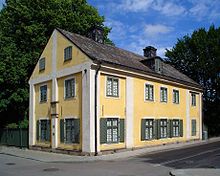
Linné's home in Uppsala stood on the grounds of the university's botanical garden.
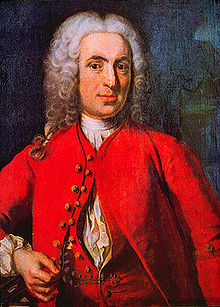
Linné shortly after his marriage (1739). Portrait of Johan Henrik Scheffel (1690-1781).

The drawing made by Georg Dionysius Ehret, on which he depicted Linné's classification system of plants.
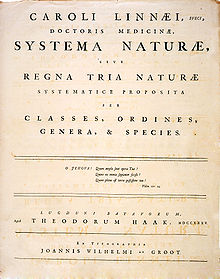
The title page of the 1st edition of Systema Naturae, in which Linné first presented his system for classifying the three kingdoms of nature in 1735.
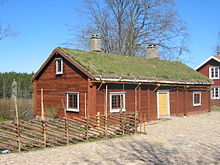
The surroundings of Linné's birthplace in Råshult have been restored to the way he experienced them in his childhood.

Linné liked to present himself in the clothes he had bought especially for his trip to Lapland. Detail of a portrait by Hendrik Hollander (copy from 1853).
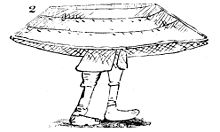
Linné's diary of the Lapland journey contains numerous drawings. Here he has sketched a Laplander carrying his boat.
Reception and aftermath
William Thomas Stearn, a British botanist active in the 20th century, summarized Linné's importance as follows:
"Although Linné has been called a pioneering ecologist, geobotanist, dendrochronologist, evolutionist, botanical pornographer, and sexist, among many other things, his most influential and valuable contributions to biology undeniably consist in the successful introduction of binary nomenclature for plant and animal species, even though this achievement was only an incidental by-product of his enormous encyclopedic activity to provide in concise, precise, and practical form the means for recognizing and recording their genera and species.“
- William Thomas Stearn: In: The Compleat Naturalist: A Life of Linnaeus. 2004
Lifework
With his inventories Species Plantarum (for plants, 1753) and Systema Naturae (for plants, animals and minerals, 1758/1759 and 1766-1768, respectively) Linné created the foundations of modern botanical and zoological nomenclature. In these two works he additionally gave an epithet to each species described. Together with the name of the genus, it served as an abbreviation of the actual species name, which consisted of a long descriptive word group (phrase). Canna foliis ovatis utrinque acuminatis nervosis thus became the easily remembered name Canna indica. The result of the introduction of two-part names is the consistent separation of the description of a species from its naming. This separation allowed newly discovered plant species to be included in his systematics without difficulty. Linné's systematics encompassed the three natural kingdoms of minerals (including fossils), plants, and animals. In contrast to his contributions to botany and zoology, whose fundamental importance for biological systematics was quickly recognized, his mineralogical investigations remained meaningless because he lacked the necessary chemical knowledge. The first chemically based classification of minerals was established in 1758 by Axel Frederic von Cronstedt.
In fundamental opposition to Linné's view that all of nature can be captured in a taxonomy was the contemporary naturalist Georges-Louis Leclerc de Buffon. Buffon believed that nature was too diverse and too rich to conform to such a strict framework. The philosopher Michel Foucault described Linné's approach to classification as being concerned with "systematically seeing few things." In particular, he was concerned with resolving the similarities between things in the world. Thus, in his Philosophia Botanica, Linné wrote, "All the dark resemblances have been introduced only to the disgrace of art." Linné also assumed the constancy of species: "There are as many species as God created in the beginning as different forms." He deliberately divided species into classes and orders on the basis of artificially selected characteristics such as number, shape, size ratio, and position, in order to create an easy-to-use and easy-to-learn system for classifying species. In plants, for example, he used features of the stamens to determine the class and features of the pistils to determine the order of a plant species. In this way, he created what he called an "artificial system" because it did not take into account the natural relationships among species. He considered the genera and species to be natural and therefore ordered them according to their similarity using a variety of characters. Linné strove to create a "natural system" but did not get beyond approaches such as Ordines Naturales in the sixth edition of Genera Plantarum (1764). For plants, only Antoine-Laurent de Jussieu succeeded in establishing such a natural system.
Awards and recognition
Linné was appointed archiater (personal physician) to the king on 30 January 1747. On 27 April 1753 he was awarded the Order of the North Star. At the end of 1756 Carl Linnaeus was ennobled by the Swedish king Adolf Friedrich and received the name Carl von Linné. The letter of nobility dated on 20 April 1757 was signed by the king in November 1761. The elevation to the nobility became effective only at the end of 1762 with the confirmation by the Riddarhuset.
Linné was a member of numerous scientific academies and learned societies. These included the German Academy of Natural Scientists Leopoldina, to which he belonged from 3 October 1736 (matriculation no. 464) under the academic epithet Dioscorides II. the Royal Society of Sciences in Uppsala, the Société Royale des Sciences de Montpellier, the Royal Prussian Academy of Sciences, the Royal Society, the Académie royale des Sciences, Inscriptions et Belles-Lettres de Toulouse, the Paris Academy of Sciences, the Russian Academy of Sciences in Saint Petersburg and the Royal Grand-British Churfürstliche Braunschweigische Lüneburgische Landwirthschaftsgesellschaft Celle.
Jan Frederik Gronovius named the genus Linnaea (moss bell) of the plant family Linnaeaceae in Linné's honour. Likewise, the lunar crater Linné in the Mare Serenitatis, the asteroid Linnaeus as well as the mineral Linneit are named after him. Furthermore, he is the namesake of the Linnaeus Terrace in Antarctica.
In 1959, botanist William Thomas Stearn proposed Carl von Linné's skeleton, buried in Uppsala Cathedral, as the lectotype for the species Homo sapiens. Homo sapiens was thereby validly defined according to the zoological rules of nomenclature as the species to which Carl von Linné belonged.
The 100 krona Swedish krona banknote carried Carl von Linné's effigy from 2001 until 30 June 2017.
Estate and correspondence
After Linné's death and the death of his son Carl, his wife Sara offered the entire estate to Joseph Banks for purchase for 3000 guineas. However, the latter refused and convinced James Edward Smith to acquire the collection. In October 1784, Linné's collection arrived in London and was put on public display at Chelsea. Linné's estate is now owned by the London Linné Society, whose highest honour is the annual Linné Medal.
Linné maintained an extensive correspondence with partners all over the world until his death. Of these, about 200 were from Sweden and 400 from other countries. Over 5000 letters have been preserved. His correspondence with Abraham Bäck, his close friend and confidant, alone comprises well over 500 letters.
Important botanical and zoological correspondents were Herman Boerhaave, Johannes Burman, Jan Frederik Gronovius and Adriaan van Royen in Holland, Joseph Banks, Mark Catesby, Peter Collinson, Philip Miller, James Petiver and Hans Sloane in England, Johann Reinhold Forster, Johann Gottlieb Gleditsch, Johann Georg Gmelin and Albrecht von Haller in Germany, Nikolaus Joseph von Jacquin in Austria, and Antoine Nicolas Duchesne and Bernard de Jussieu in France.
Critics
The analogy of plants and animals regarding their sexuality, used by Linné already in 1729 as a student in Praeludia Sponsaliorum Plantarum, provoked criticism from several of his contemporaries.
A first criticism of Linné's sexual system of plants was written by Johann Georg Siegesbeck in 1737 in an appendix to his treatise Botanosophiae: "[If] eight, nine, ten, twelve, or even twenty and more men are found in the same bed with one woman [or if] where the beds of the real married form a circle, the beds of the harlots also form a circle, so that those of married men are mated [...] Who would like to believe that such detestable fornication has been established by God in the realm of plants? Who could expound such unchaste system to the academic youth without giving offence?"
Julien Offray de La Mettrie mocked Linné's system in L'Homme Plante (1748, shortly thereafter part of L'Homme Machine), in which he classified humanity using terms introduced by Linné. He referred to mankind as Dioecia (i.e. male and female flowers on different plants). Males belong to the order Monandria (a stamen) and females to the order Monogyna (a pistil). He interpreted the sepals as clothing, the corollas as limbs, the nectaries as breasts, and so on.
Even Johann Wolfgang von Goethe, who confessed that "after Shakespeare and Spinoza, the greatest effect on me [has] proceeded from Linné, and that precisely through the antagonism to which he called upon me," judged: "When innocent souls, in order to advance by their own study, take up botanical textbooks, they cannot conceal that their moral feeling is offended; the eternal marriages which one cannot get rid of, whereby the monogamy on which custom, law, and religion are founded, entirely dissolves into vague lasciviousness, remains intolerable to the pure sense of man.“
In 2016, a commission chaired by Bernd Martin advised the city of Freiburg im Breisgau, whose members included Nina Degele, to add an additional sign under the street sign of Carl-von-Linné-Straße with the wording: "Swedish natural scientist and founder of biological systematics, mastermind of a biologically based gender hierarchy and racial doctrine". Ulrich Kutschera criticized the commission; it discredited "a great biologist", and many of its statements were also "factually incorrect". Axel Meyer called Linné an important founder of modern biology, who is defamed by the Freiburg shield. He said that those responsible in Freiburg seemed to him as if they were trying to reprogram man's evolutionary heritage by using counter-gendered neologisms about a scientific genius. Such attempts show him the hubris of gender studies, which do not want to describe humans or understand them better, but to re-educate them ideologically.
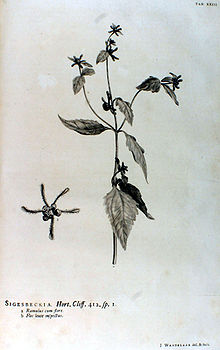
In the Hortus Cliffortianus Linné named the genus Sigesbeckia after Johann Georg Siegesbeck, who became one of his most outspoken critics a little later. The drawing is by Jan Wandelaar.

The moss bell is named after Linné.
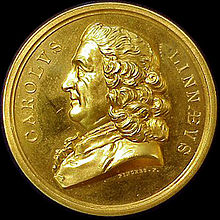
The Linné Medal has been awarded annually by the Linnean Society of London since 1888.
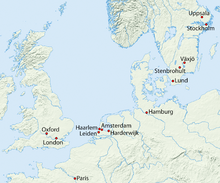
Places of activity of Linné
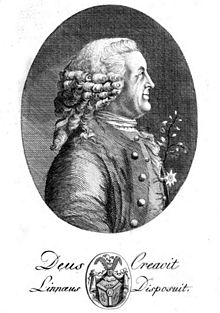
Anonymous portrait with the inscription "Deus creavit, Linnaeus disposuit" ("God created, Linné ordered") from Dietrich Heinrich Stöver's Life of the Knight Carl von Linné from 1792
Search within the encyclopedia